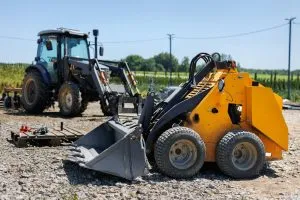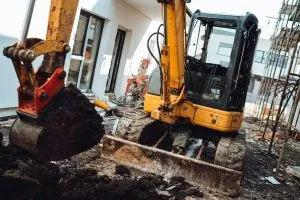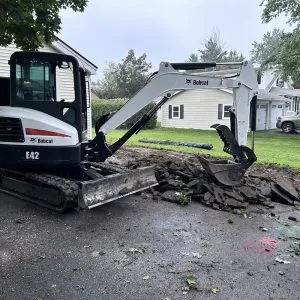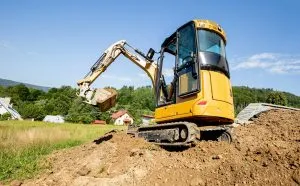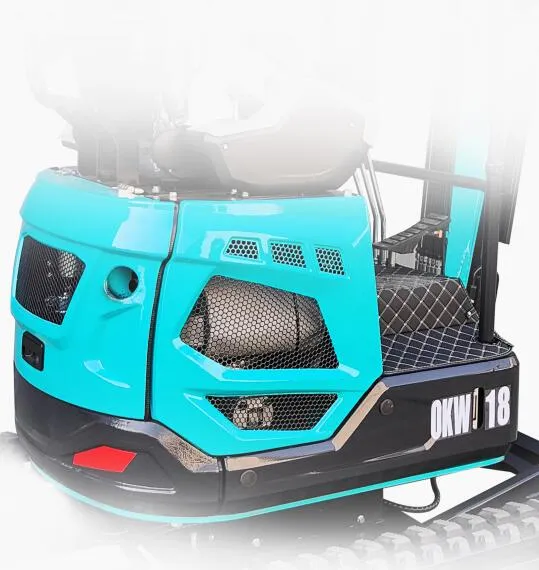
- Smooth operation method
During operation, the stability of the machine can not only improve work efficiency and extend the life of the machine but also ensure safe operation (put the machine on a relatively flat ground); the driving sprocket is more stable on the backside than on the front side, and It can prevent the final drive from being impacted by external forces; the wheelbase of the track on the ground is always greater than the wheelbase, so the forward working stability is good, and lateral operation should be avoided as much as possible; the digging point should be kept close to the machine to improve stability and excavator; If the excavation point is far away from the machine, the operation will be unstable due to the shift of the center of gravity; the lateral excavation is less stable than the forward excavation. If the excavation point is far from the center of the machine body, the machine will be more unstable, so the excavation point and the center of the machine body should be kept suitable Distance to make the operation balanced and efficient. - Noteworthy operations
The hydraulic cylinder is equipped with a buffer device, which can gradually release the back pressure near the end of the stroke; if an impact load is applied after reaching the end of the stroke, the piston will directly touch the cylinder head or the bottom of the cylinder, which may cause accidents. Try to
Leave a gap. The use of rotary motion for bulldozing will cause abnormal force on the bucket and working equipment, resulting in distortion or cracking of the weld seam and even pin fracture. This operation should be avoided as much as possible. Excavation by the weight of the machine body will cause the slewing bearing to be abnormally stressed. Simultaneously, it will produce strong vibration and impact on the chassis, so the application of hydraulic cylinders or hydraulic pipelines will cause greater damage. When loading and unloading heavier materials such as rocks, the materials should be unloaded close to the bottom of the trunk compartment, loaded with soil first, and then loaded with rocks. Unloading at high altitudes is prohibited from reducing impact damage to the truck. When the crawler is deep in the mud, place a wooden board under the bucket, use the bucket’s bottom to support the crawler, and then place a wooden board under the crawler to drive the machine out. - Correct walking operation When the excavator is walking, the working equipment should be stowed as far as possible and close to the machine body’s center to maintain stability; put the final drive behind to protect the final drive. Try to avoid driving over obstacles such as tree stumps and rocks to prevent the track from twisting.
If you must drive over an obstacle, ensure that the track’s center is on the obstacle. When passing the mound, always use work equipment to support the chassis to prevent violent shaking or even the car body’s tipping. Avoid stopping the engine at idle for a long time on a steep slope. Otherwise, it will cause poor lubrication due to changes in the oil level angle. The machine’s long-distance travel will cause the high temperature inside the supporting wheels and final drive due to long-term rotation, lower oil viscosity, and poor lubrication, so it should be stopped frequently to cool down extend the life of the lower body. It is forbidden to excavate by the driving force of walking. Otherwise, the excessive load will cause the early wear or damage of the final drive and crawler parts. When walking uphill, the driving wheel should be behind to increase the adhesion of the crawler. When walking downhill, the driving wheels should be in front, and the upper crawler belt should be tightened to prevent the car body from sliding forward under the action of gravity when parking and causing danger. When walking on a slope, the work gear should be in front to ensure safety. After parking, gently insert the bucket into the ground and put a stop under the track. When turning on a steep slope, slow down and turn left when turning left.
Crawler, turn the right crawler backward when turning right; this pro can reduce the danger when turning on slopes. - The correct crushing operation must first place the hammer vertically on the object to be crushed. When starting the crushing operation, lift the front car body about 5cm. When crushing, the crushing head should always be pressed on the crushed material. The crushing operation should be stopped immediately after the unbroken material has been crushed. When crushing, because the vibration will gradually change the hammerhead’s direction, the bucket cylinder should be adjusted at any time to make the direction of the hammerhead perpendicular to the surface of the broken object. When the hammer cannot penetrate the broken object, change the crushing position; do not continue to crush at the following place for more than one minute, otherwise, not only the hammer will be damaged, but the oil temperature will increase abnormally; for hard objects, start gradually from the edge broken. It is strictly forbidden to break while turning, twist the hammerhead after insertion, use the hydraulic hammer horizontally or upwards, and use it as a chisel.
Concept: Excavator, also known as excavating machinery, is an earth-moving machine that uses a bucket to excavate materials above or below the bearing surface and load them into a transport vehicle or unload it stockyard. The materials excavated by the excavator are mainly soil, coal, silt, and pre-loose soil and rocks. From the development of construction machinery in recent years, excavators’ development is relatively fast, and excavators have become one of the most important construction machinery in engineering construction. The three most important parameters of an excavator: operating weight (mass), engine power, and bucket capacity.


